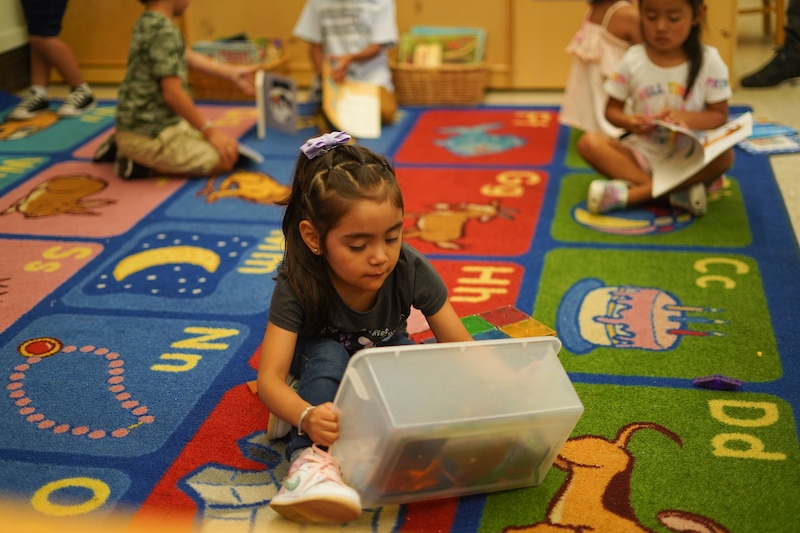Rebecca Rodriguez sits on a multicolored rug reading to more than a dozen 3- and 4-year-olds in her classroom at Haugan Elementary in Albany Park on the Northwest side.
She’s been teaching preschool for more than a decade, including during the summer. But, since the pandemic began, Rodriguez said she has been dealing with new challenges in the classroom.
“The last two years, we have received students who don’t know how to play with each other. They don’t have social skills,” she said. “They’ll sit back-to-back instead of face-to-face if they are in the block center.”
The pandemic took a toll on the city’s youngest learners, who were often attending school for the very first time online. Many just didn’t enroll.
Now, Chicago Public Schools is hoping to bounce back from that pandemic enrollment decline in the early grades. Officials are urging parents to sign their children up for preschool this coming school year, citing about 4,000 open spots in full-day programs and 1,000 spots open in half-day ones.
The push comes after Chicago saw a 34% decline in young children enrolling in preschool in 2020. State law doesn’t require children to go to school until age 6, making preschool and even kindergarten optional.
Chicago has long offered free preschool to low-income 3- and 4-year-olds, but in 2018 former Chicago Mayor Rahm Emanuel promised to offer free universal pre-K to the city’s 4-year-olds by 2021.The COVID-19 pandemic delayed the effort, but this year, a district spokesperson said, there are spots for 14,500 children to attend a full-day of pre-K.
In the spring, the district rolled out a new process for applying to all preschool programs, but a glitch in the system frustrated parents. A Chalkbeat analysis also showed that the district had a net loss of 19 classrooms. Officials said these classrooms could reopen depending on enrollment this fall.
As of Aug. 1, more than 20,000 applications had been submitted by 9,400 applicants for full-day pre-K programs at 367 district-run elementary schools, according to CPS records obtained by Chalkbeat. Of these applications, two-thirds were for 4-year-olds.

Haugan Elementary received 166 applicants for its 100 seats offered, according to Leslie Mckinily, deputy chief of early childhood education. Nearly half of the applicants were 4-year-olds, according to data obtained by Chalkbeat. The last two years, district records show, the school enrolled around 60 pre-kindergarteners, down from close to 100 the year the pandemic started.
The district engaged in a “robust” outreach and marketing for pre-K this year, Leslie Mckinily said. CPS placed advertisements online, on billboards, and in bus shelters, in addition to partnering with libraries, doctor offices, local offices of the Women Infant Child Program, the Chicago Housing Authority, and aldermen in various wards to get the information out.
The Early Childhood Office is regularly reviewing data and working with Community Organizing and Family Issues, better known as COFI, to reach communities that struggle with enrollment. Mckinily said there are 26 community areas with historically low preschool enrollment that the district is targeting.
The family engagement team in the district’s early childhood office has also worked with schools to build customized recruitment plans. Mckinily said resources that went to schools allowed staff to go door-to-door and for clerks to work additional hours to make calls to families.
At Haugan, summer programs, such as the one Rodriguez teaches, help boost pre-K enrollment for the year, said Melissa Sanchez, the school’s assistant principal.
Community events, which are held throughout the school year, are another key method of encouraging enrollment in preschool at Haugan, Sanchez said. By the end of summer, the school will have hosted parent workshops, ice cream socials, bike safety events, and movie nights.
To enroll children in pre-K, families start the three-step application process online. Those in temporary living situations, with income 100% below the federal poverty line, and with children who have Individualized Education Programs are prioritized, according to CPS. Families who apply to schools close to where they live are also prioritized.
Dipali Bharadwaj, whose 4-year-old daughter is in the summer pre-K program at Haugan Elementary, said it’s convenient and affordable. Her family lives close to the school. This will be the first year her daughter will attend pre-K, instead of day care.
“She’s a little nervous going to a big school where there are older kids too, so there’s some anxiety about transitioning into the school year,” Bharadwaj said. “But I like the idea of a public school system where she’s just going to interact with a broader range of more diverse kids.”

During the summer programs, Rodriguez said, she introduces children to routines, expectations, creativity, and rules. Children also learn how to play with different materials and socialize with each other.
Many of the summer students return for the pre-K program during the school year and the transition programs help prepare them for a full day of instruction, she said. They are introduced sooner to the use of “red and green rules” and songs to cue transitions such as clean-up, she said. “Quiet time,” used for naps, reading, and similar activities, is implemented in full-time programs.
Family involvement is also a key part of pre-K at Haugan. Teachers speak to families to learn about cultural sensitivities and encourage parents to celebrate different holidays with the students, Rodriguez said. Last year, some parents came to class to read books to their children.
Sanchez said Haugan Elementary will be hosting a parent volunteer meeting ahead of the first day so its parents can better understand how they can get involved.
Families interested in applying for pre-K can visit the CPS early childhood website at this link: https://www.cps.edu/schools/attend-a-cps-school/apply-for-next-year/.
Eileen Pomeroy is a reporting intern for Chalkbeat Chicago. Contact Eileen at epomeroy@chalkbeat.org.

